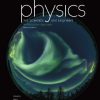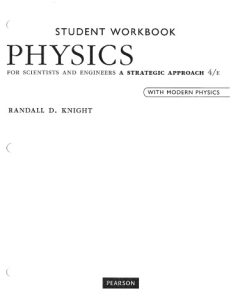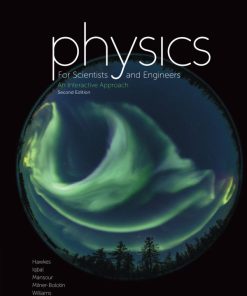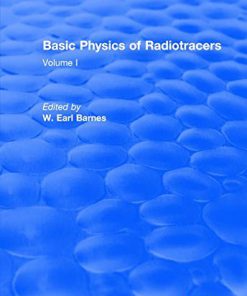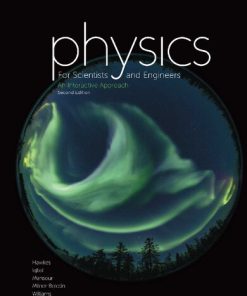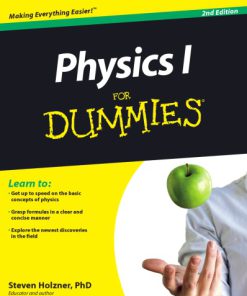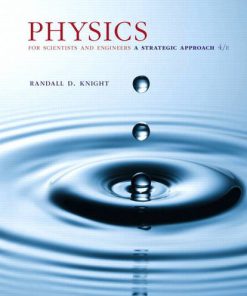Physics for Scientists and Engineers with Modern Physics 10th Edition by Raymond Serway 9781337553292 1337553298
$50.00 Original price was: $50.00.$25.00Current price is: $25.00.
Physics for Scientists and Engineers with Modern Physics 10th Edition by Raymond Serway – Ebook PDF Instant Download/Delivery: 9781337553292, 1337553298
Full download Physics for Scientists and Engineers with Modern Physics 10th Edition after payment

Product details:
• ISBN 10:1337553298
• ISBN 13:9781337553292
• Author:Raymond Serway
Physics for Scientists and Engineers with Modern Physics
Taking an integrative approach, market-leading PHYSICS FOR SCIENTISTS AND ENGINEERS WITH MODERN PHYSICS, Tenth Edition seamlessly matches curated content to the learning environment for which it was intended–from in-class group problem solving to online homework that utilizes targeted feedback and tutorials. More student friendly than ever, the text includes new context-rich exercises, Think-Pair-Share problems, MCAT-style passage problems and sound educational pedagogy. The unified art program and detailed worked examples compliment the concise language and meticulous instruction for which Raymond A. Serway and John W. Jewett Jr. are known. In addition, WebAssign–the world’s easiest to use homework system–equips you with the definitive solution to your homework and assessment needs to maximize your course success.
Physics for Scientists and Engineers with Modern Physics 10th Table of contents:
Part 1. Mechanics
Chapter 1. Physics and Measurement
1.1. Standards of Length, Mass, and Time
Length
Mass
Time
1.2. Modeling and Alternative Representations
1.3. Dimensional Analysis
1.4. Conversion of Units
1.5. Estimates and Order-of-Magnitude Calculations
1.6. Significant Figures
Definitions
Concepts and Principles
Problems Icon Guide
Think–Pair–Share
Problems: Section 1.1. Standards of Length, Mass, and Time
Problems: Section 1.2. Modeling and Alternative Representations
Problems: Section 1.3. Dimensional Analysis
Problems: Section 1.4. Conversion of Units
Problems: Section 1.5. Estimates and Order-of-Magnitude Calculations
Problems: Section 1.6. Significant Figures
Problems: Additional Problems
Problems: Challenge Problem
Chapter 2. Motion in One Dimension
2.1. Position, Velocity, and Speed of a Particle
2.2. Instantaneous Velocity and Speed
2.3. Analysis Model: Particle Under Constant Velocity
2.4. The Analysis Model Approach to Problem-Solving
Conceptualize
Categorize
Analyze
Finalize
2.5. Acceleration
2.6. Motion Diagrams
2.7. Analysis Model: Particle Under Constant Acceleration
2.8. Freely Falling Objects
2.9. Kinematic Equations Derived from Calculus
Kinematic Equations
Definitions
Concepts and Principles
Analysis Models for Problem-Solving
Problems Icon Guide
Think–Pair–Share
Problems: Section 2.1. Position, Velocity, and Speed
Problems: Section 2.2. Instantaneous Velocity and Speed
Problems: Section 2.3. Analysis Model: Particle Under Constant Velocity
Problems: Section 2.5. Acceleration
Problems: Section 2.6. Motion Diagrams
Problems: Section 2.7. Analysis Model: Particle Under Constant Acceleration
Problems: Section 2.8. Freely Falling Objects
Problems: Section 2.9. Kinematic Equations Derived from Calculus
Problems: Additional Problems
Problems: Challenge Problems
Chapter 3. Vectors
3.1. Coordinate Systems
3.2. Vector and Scalar Quantities
3.3. Basic Vector Arithmetic
3.4. Components of a Vector and Unit Vectors
Definitions
Concepts and Principles
Problems Icon Guide
Think–Pair–Share
Problems: Section 3.1. Coordinate Systems
Vector and Scalar Quantities.
Problems: Section 3.3. Basic Vector Arithmetic
Problems: Section 3.4. Components of a Vector and Unit Vectors
Problems: Additional Problems
Problems: Challenge Problem
Chapter 4. Motion in Two Dimensions
4.1. The Position, Velocity, and Acceleration Vectors
4.2. Two-Dimensional Motion with Constant Acceleration
4.3. Projectile Motion
Horizontal Range and Maximum Height of a Projectile
4.4. Analysis Model: Particle in Uniform Circular Motion
4.5. Tangential and Radial Acceleration
4.6. Relative Velocity and Relative Acceleration
Definitions
Concepts and Principles
Analysis Model for Problem Solving
Problems Icon Guide
Think–Pair–Share
Problems: Section 4.1. The Position, Velocity, and Acceleration Vectors
Problems: Section 4.2. Two-Dimensional Motion with Constant Acceleration
Problems: Section 4.3. Projectile Motion
Problems: Section 4.4. Analysis Model: Particle in Uniform Circular Motion
Problems: Section 4.5. Tangential and Radial Acceleration
Problems: Section 4.6. Relative Velocity and Relative Acceleration
Problems: Additional Problems
Problems: Challenge Problems
Chapter 5. The Laws of Motion
5.1. The Concept of Force
The Vector Nature of Force
5.2. Newton’s First Law and Inertial Frames
5.3. Mass
5.4. Newton’s Second Law
5.5. The Gravitational Force and Weight
5.6. Newton’s Third Law
5.7. Analysis Models Using Newton’s Second Law
Analysis Model: The Particle in Equilibrium
Analysis Model: The Particle Under a Net Force
5.8. Forces of Friction
Definitions
Concepts and Principles
Analysis Models for Problem Solving
Problems Icon Guide
Think–Pair–Share
Problems: Section 5.1. The Concept of Force
Problems: Section 5.4. Newton’s Second Law
Problems: Section 5.5. The Gravitational Force and Weight
Problems: Section 5.6. Newton’s Third Law
Problems: Section 5.7. Analysis Models Using Newton’s Second Law
Problems: Section 5.8. Forces of Friction
Problems: Additional Problems
Problems: Challenge Problems
Chapter 6. Circular Motion and Other Applications of Newton’s Laws
6.1. Extending the Particle in Uniform Circular Motion Model
6.2. Nonuniform Circular Motion
6.3. Motion in Accelerated Frames
6.4. Motion in the Presence of Resistive Forces
Model 1: Resistive Force Proportional to Object Velocity
Model 2: Resistive Force Proportional to Object Speed Squared
Concepts and Principles
Analysis Model for Problem-Solving
Problems Icon Guide
Think–Pair–Share
Problems: Section 6.1. Extending the Particle in Uniform Circular Motion Model
Problems: Section 6.2. Nonuniform Circular Motion
Problems: Section 6.3. Motion in Accelerated Frames
Problems: Section 6.4. Motion in the Presence of Resistive Forces
Problems: Additional Problems
Problems: Challenge Problems
Chapter 7. Energy of a System
7.1. Systems and Environments
7.2. Work Done by a Constant Force
7.3. The Scalar Product of Two Vectors
7.4. Work Done by a Varying Force
Work Done by a Spring
7.5. Kinetic Energy and the Work–Kinetic Energy Theorem
7.6. Potential Energy of a System
Elastic Potential Energy
Energy Bar Charts
7.7. Conservative and Nonconservative Forces
Conservative Forces
Nonconservative Forces
7.8. Relationship Between Conservative Forces and Potential Energy
7.9. Energy Diagrams and Equilibrium of a System
Definitions
Concepts and Principles
Problems Icon Guide
Think–Pair–Share
Problems: Section 7.2. Work Done by a Constant Force
Problems: Section 7.3. The Scalar Product of Two Vectors
Problems: Section 7.4. Work Done by a Varying Force
Problems: Section 7.5. Kinetic Energy and the Work–Kinetic Energy Theorem
Problems: Section 7.6. Potential Energy of a System
Problems: Section 7.7. Potential Energy of a System
Problems: Section 7.8. Relationship Between Conservative Forces and Potential Energy
Problems: Section 7.9. Energy Diagrams and Equilibrium of a System
Problems: Additional Problems
Problems: Challenge Problems
Chapter 8. Conservation of Energy
8.1. Analysis Model: Nonisolated System (Energy)
8.2. Analysis Model: Isolated System (Energy)
8.3. Situations Involving Kinetic Friction
8.4. Changes in Mechanical Energy for Nonconservative Forces
8.5. Power
Definitions
Concepts and Principles
Analysis Models for Problem Solving
Problems Icon Guide
Think–Pair–Share
Problems: Section 8.1. Analysis Model: Nonisolated System (Energy)
Problems: Section 8.2. Analysis Model: Isolated System (Energy)
Problems: Section 8.3. Situations Involving Kinetic Friction
Problems: Section 8.4. Changes in Mechanical Energy for Nonconservative Forces
Problems: Section 8.5. Power
Problems: Additional Problems
Problems: Challenge Problems
Chapter 9. Linear Momentum and Collisions
9.1. Linear Momentum
9.2. Analysis Model: Isolated System (Momentum)
9.3. Analysis Model: Nonisolated System (Momentum)
9.4. Collisions in One Dimension
Perfectly Inelastic Collisions
Elastic Collisions
9.5. Collisions in Two Dimensions
9.6. The Center of Mass
9.7. Systems of Many Particles
9.8. Deformable Systems
9.9. Rocket Propulsion
Definitions
Concepts and Principles
Analysis Models for Problem Solving
Problems Icon Guide
Think–Pair–Share
Problems: Section 9.1. Linear Momentum
Problems: Section 9.2. Analysis Model: Isolated System (Momentum)
Problems: Section 9.3. Analysis Model: Nonisolated System (Momentum)
Problems: Section 9.4. Collisions in One Dimension
Problems: Section 9.5. Collisions in Two Dimensions
Problems: Section 9.6. The Center of Mass
Problems: Section 9.7. Systems of Many Particles
Problems: Section 9.8. Deformable Systems
Problems: Section 9.9. Rocket Propulsion
Problems: Additional Problems
Problems: Challenge Problems
Chapter 10. Rotation of a Rigid Object About a Fixed Axis
10.1. Angular Position, Velocity, and Acceleration
10.2. Analysis Model: Rigid Object Under Constant Angular Acceleration
10.3. Angular and Translational Quantities
10.4. Torque
10.5. Analysis Model: Rigid Object Under a Net Torque
10.6. Calculation of Moments of Inertia
10.7. Rotational Kinetic Energy
10.8. Energy Considerations in Rotational Motion
10.9. Rolling Motion of a Rigid Object
Definitions
Concepts and Principles
Analysis Models for Problem-Solving
Problems Icon Guide
Think–Pair–Share
Problems: Section 10.1. Angular Position, Velocity, and Acceleration
Problems: Section 10.2. Analysis Model: Rigid Object Under Constant Angular Acceleration
Problems: Section 10.3. Angular and Translational Quantities
Problems: Section 10.4. Torque
Problems: Section 10.5. Analysis Model: Rigid Object Under a Net Torque
Problems: Section 10.6. Calculation of Moments of Inertia
Problems: Section 10.7. Rotational Kinetic Energy
Problems: Section 10.8. Energy Considerations in Rotational Motion
Problems: Section 10.9. Rolling Motion of a Rigid Object
Problems: Additional Problems
Problems: Challenge Problems
Chapter 11. Angular Momentum
11.1. The Vector Product and Torque
11.2. Analysis Model: Nonisolated System (Angular Momentum)
Angular Momentum of a System of Particles
11.3. Angular Momentum of a Rotating Rigid Object
11.4. Analysis Model: Isolated System (Angular Momentum)
11.5. The Motion of Gyroscopes and Tops
Definitions
Concepts and Principles
Analysis Models for Problem-Solving
Problems Icon Guide
Think–Pair–Share
Problems: Section 11.1. The Vector Product and Torque
Problems: Section 11.2. Analysis Model: Nonisolated System (Angular Momentum)
Problems: Section 11.3. Angular Momentum of a Rotating Rigid Object
Problems: Section 11.4. Analysis Model: Isolated System (Angular Momentum)
Problems: Section 11.5. The Motion of Gyroscopes and Tops
Problems: Additional Problems
Problems: Challenge Problems
Chapter 12. Static Equilibrium and Elasticity
12.1. Analysis Model: Rigid Object in Equilibrium
12.2. More on the Center of Gravity
12.3. Examples of Rigid Objects in Static Equilibrium
12.4. Elastic Properties of Solids
Young’s Modulus: Elasticity in Length
Shear Modulus: Elasticity of Shape
Bulk Modulus: Volume Elasticity
Prestressed Concrete
Definitions
Concepts and Principles
Analysis Model for Problem Solving
Problems Icon Guide
Think–Pair–Share
Problems: Section 12.1. Analysis Model: Rigid Object in Equilibrium
Problems: Section 12.2. More on the Center of Gravity
Problems: Section 12.3. Examples of Rigid Objects in Static Equilibrium
Problems: Section 12.4. Elastic Properties of Solids
Problems: Additional Problems
Problems: Challenge Problems
Chapter 13. Universal Gravitation
13.1. Newton’s Law of Universal Gravitation
13.2. Free-Fall Acceleration and the Gravitational Force
13.3. Analysis Model: Particle in a Field (Gravitational)
13.4. Kepler’s Laws and the Motion of Planets
Kepler’s First Law
Kepler’s Second Law
Kepler’s Third Law
13.5. Gravitational Potential Energy
13.6. Energy Considerations in Planetary and Satellite Motion
Escape Speed
Black Holes
Dark Matter
Definitions
Concepts and Principles
Analysis Model for Problem Solving
Problems Icon Guide
Think–Pair–Share
Problems: Section 13.1. Newton’s Law of Universal Gravitation
Problems: Section 13.2. Free-Fall Acceleration and the Gravitational Force
Problems: Section 13.3. Analysis Model: Particle in a Field (Gravitational)
Problems: Section 13.4. Kepler’s Laws and the Motion of Planets
Problems: Section 13.5. Gravitational Potential Energy
Problems: Section 13.6. Energy Considerations in Planetary and Satellite Motion
Problems: Additional Problems.
Problems: Challenge Problem.
Chapter 14. Fluid Mechanics
14.1. Pressure
14.2. Variation of Pressure with Depth
14.3. Pressure Measurements
14.4. Buoyant Forces and Archimedes’s Principle
Case 1: Totally Submerged Object
14.5. Fluid Dynamics
14.6. Bernoulli’s Equation
14.7. Flow of Viscous Fluids in Pipes
14.8. Other Applications of Fluid Dynamics
Definitions
Concepts and Principles
Problems Icon Guide
Think–Pair–Share
Problems: Section 14.1. Pressure
Problems: Section 14.2. Variation of Pressure with Depth
Problems: Section 14.3. Pressure Measurements
Problems: Section 14.4. Buoyant Forces and Archimedes’s Principle
Problems: Section 14.5. Fluid Dynamics
Problems: Section 14.6. Bernoulli’s Equation
Problems: Section 14.7. Flow of Viscous Fluids in Pipes
Problems: Section 14.8. Other Applications of Fluid Dynamics
Problems: Additional Problems
Problems: Challenge Problems
Part 2. Oscillations and Mechanical Waves
Chapter 15. Oscillatory Motion
15.1. Motion of an Object Attached to a Spring
15.2. Analysis Model: Particle in Simple Harmonic Motion
15.3. Energy of the Simple Harmonic Oscillator
15.4. Comparing Simple Harmonic Motion with Uniform Circular Motion
15.5. The Pendulum
Physical Pendulum
Torsional Pendulum
15.6. Damped Oscillations
15.7. Forced Oscillations
Concepts and Principles
Analysis Model for Problem Solving
Problems Icon Guide
Think–Pair–Share
Problems: Section 15.1. Motion of an Object Attached to a Spring
Problems: Section 15.2. Analysis Model: Particle in Simple Harmonic Motion
Problems: Section 15.3. Energy of the Simple Harmonic Oscillator
Problems: Section 15.4. Comparing Simple Harmonic Motion with Uniform Circular Motion
Problems: Section 15.5. The Pendulum
Problems: Section 15.6. Damped Oscillations
Problems: Section 15.7. Forced Oscillations
Problems: Additional Problems
Problems: Challenge Problems
Chapter 16. Wave Motion
16.1. Propagation of a Disturbance
16.2. Analysis Model: Traveling Wave
Sinusoidal Waves on Strings
16.3. The Speed of Waves on Strings
16.4. Rate of Energy Transfer by Sinusoidal Waves on Strings
16.5. The Linear Wave Equation
16.6. Sound Waves
16.7. Speed of Sound Waves
16.8. Intensity of Sound Waves
Sound Level in Decibels
Loudness and Frequency
16.9. The Doppler Effect
Shock Waves
Definitions
Concepts and Principles
Analysis Model for Problem Solving
Problems Icon Guide
Think–Pair–Share
Problems: Section 16.1. Propagation of a Disturbance
Problems: Section 16.2. Analysis Model: Traveling Wave
Problems: Section 16.3. The Speed of Waves on Strings
Problems: Section 16.4. Rate of Energy Transfer by Sinusoidal Waves on Strings
Problems: Section 16.5. The Linear Wave Equation
Problems: Section 16.6. Sound Waves
Problems: Section 16.7. Speed of Sound Waves
Problems: Section 16.8. Intensity of Sound Waves
Problems: Section 16.9. The Doppler Effect
Problems: Additional Problems
Problems: Challenge Problems
Chapter 17. Superposition and Standing Waves
17.1. Analysis Model: Waves in Interference
Superposition of Sinusoidal Waves
17.2. Standing Waves
17.3. Boundary Effects: Reflection and Transmission
17.4. Analysis Model: Waves Under Boundary Conditions
17.5. Resonance
17.6. Standing Waves in Air Columns
17.7. Beats: Interference in Time
17.8. Nonsinusoidal Waveforms
Concepts and Principles
Analysis Models for Problem Solving
Problems Icon Guide
Think–Pair–Share
Problems: Section 17.1. Analysis Model: Waves in Interference
Problems: Section 17.2. Standing Waves
Problems: Section 17.4. Analysis Model: Waves Under Boundary Conditions
Problems: Section 17.5. Resonance
Problems: Section 17.6. Standing Waves in Air Columns
Problems: Section 17.7. Beats: Interference in Time
Problems: Section 17.8. Nonsinusoidal Waveforms
Problems: Additional Problems
Problems: Challenge Problem
Part 3. Thermodynamics
Chapter 18. Temperature
18.1. Temperature and the Zeroth Law of Thermodynamics
18.2. Thermometers and the Celsius Temperature Scale
18.3. The Constant-Volume Gas Thermometer and the Absolute Temperature Scale
The Celsius, Fahrenheit, and Kelvin Temperature Scales
18.4. Thermal Expansion of Solids and Liquids
The Unusual Behavior of Water
18.5. Macroscopic Description of an Ideal Gas
Definitions
Concepts and Principles
Problems Icon Guide
Think–Pair–Share
Problems: Section 18.2. Thermometers and the Celsius Temperature Scale
Problems: Section 18.3. The Constant-Volume Gas Thermometer and the Absolute Temperature Scale
Problems: Section 18.4. Thermal Expansion of Solids and Liquids
Problems: Section 18.5. Macroscopic Description of an Ideal Gas
Problems: Additional Problems
Problems: Challenge Problems
Chapter 19. The First Law of Thermodynamics
19.1. Heat and Internal Energy
Units of Heat
The Mechanical Equivalent of Heat
19.2. Specific Heat and Calorimetry
Calorimetry
19.3. Latent Heat
19.4. Work in Thermodynamic Processes
19.5. The First Law of Thermodynamics
19.6. Energy Transfer Mechanisms in Thermal Processes
Thermal Conduction
Home Insulation
Convection
Radiation
The Dewar Flask
Definitions
Concepts and Principles
Problems Icon Guide
Think–Pair–Share
Problems: Section 19.1. Heat and Internal Energy
Problems: Section 19.2. Specific Heat and Calorimetry
Problems: Section 19.3. Latent Heat
Problems: Section 19.4. Work in Thermodynamic Processes
Problems: Section 19.5. The First Law of Thermodynamics
Problems: Section 19.6. Energy Transfer Mechanisms in Thermal Processes
Problems: Additional Problems
Problems: Challenge Problems
Chapter 20. The Kinetic Theory of Gases
20.1. Molecular Model of an Ideal Gas
20.2. Molar Specific Heat of an Ideal Gas
20.3. The Equipartition of Energy
A Hint of Energy Quantization
20.4. Adiabatic Processes for an Ideal Gas
20.5. Distribution of Molecular Speeds
Concepts and Principles
Problems Icon Guide
Think–Pair–Share
Problems: Section 20.1. Molecular Model of an Ideal Gas
Problems: Section 20.2. Molar Specific Heat of an Ideal Gas
Problems: Section 20.3. The Equipartition of Energy
Problems: Section 20.4. Adiabatic Processes for an Ideal Gas
Problems: Section 20.5. Distribution of Molecular Speeds
Problems: Additional Problems
Problems: Challenge Problem
Chapter 21. Heat Engines, Entropy, and the Second Law of Thermodynamics
21.1. Heat Engines and the Second Law of Thermodynamics
21.2. Heat Pumps and Refrigerators
21.3. Reversible and Irreversible Processes
21.4. The Carnot Engine
21.5. Gasoline and Diesel Engines
21.6. Entropy
21.7. Entropy in Thermodynamic Systems
Entropy Change in a Carnot Cycle
Entropy Change in a Free Expansion
Entropy Change in Thermal Conduction
21.8. Entropy and the Second Law
Definitions
Concepts and Principles
Problems Icon Guide
Think–Pair–Share
Problems: Section 21.1. Heat Engines and the Second Law of Thermodynamics
Problems: Section 21.2. Heat Pumps and Refrigerators
Problems: Section 21.4. The Carnot Engine
Problems: Section 21.5. Gasoline and Diesel Engines
Problems: Section 21.6. Entropy
Problems: Section 21.7. Entropy in Thermodynamic Systems
Problems: Section 21.8. Entropy and the Second Law
Problems: Additional Problems
Problems: Challenge Problem
Part 4. Electricity and Magnetism
Chapter 22. Electric Fields
22.1. Properties of Electric Charges
22.2. Charging Objects by Induction
22.3. Coulomb’s Law
22.4. Analysis Model: Particle in a Field (Electric)
22.5. Electric Field Lines
22.6. Motion of a Charged Particle in a Uniform Electric Field
Definitions
Concepts and Principles
Analysis Models for Problem Solving
Problems Icon Guide
Think–Pair–Share
Problems: Section 22.1. Properties of Electric Charges
Problems: Section 22.3. Coulomb’s Law
Problems: Section 22.4. Analysis Model: Particle in a Field (Electric)
Problems: Section 22.5. Electric Field Lines
Problems: Section 22.6. Motion of a Charged Particle in a Uniform Electric Field
Problems: Additional Problems
Problems: Challenge Problems
Chapter 23. Continuous Charge Distributions and Gauss’s Law
23.1. Electric Field of a Continuous Charge Distribution
23.2. Electric Flux
23.3. Gauss’s Law
23.4. Application of Gauss’s Law to Various Charge Distributions
Definitions
Concepts and Principles
Problems Icon Guide
Think–Pair–Share
Problems: Section 23.1. Electric Field of a Continuous Charge Distribution
Problems: Section 23.2. Electric Flux
Problems: Section 23.3. Gauss’s Law
Problems: Section 23.4. Application of Gauss’s Law to Various Charge Distributions
Problems: Additional Problems
Problems: Challenge Problems
Chapter 24. Electric Potential
24.1. Electric Potential and Potential Difference
24.2. Potential Difference in a Uniform Electric Field
24.3. Electric Potential and Potential Energy Due to Point Charges
24.4. Obtaining the Value of the Electric Field from the Electric Potential
24.5. Electric Potential Due to Continuous Charge Distributions
24.6. Conductors in Electrostatic Equilibrium
A Cavity Within a Conductor
Definitions
Concepts and Principles
Problems Icon Guide
Think–Pair–Share
Problems: Section 24.1. Electric Potential and Potential Difference
Problems: Section 24.2. Potential Difference in a Uniform Electric Field
Problems: Section 24.3. Electric Potential and Potential Energy Due to Point Charges
Problems: Section 24.4. Obtaining the Value of the Electric Field from the Electric Potential
Problems: Section 4.5. Electric Potential Due to Continuous Charge Distributions
Problems: Section 24.6. Conductors in Electrostatic Equilibrium
Problems: Additional Problems
Problems: Challenge Problems
Chapter 25. Capacitance and Dielectrics
25.1. Definition of Capacitance
25.2. Calculating Capacitance
25.3. Combinations of Capacitors
Parallel Combination
Series Combination
25.4. Energy Stored in a Charged Capacitor
25.5. Capacitors with Dielectrics
25.6. Electric Dipole in an Electric Field
25.7. An Atomic Description of Dielectrics
Definitions
Concepts and Principles
Problems Icon Guide
Think–Pair–Share
Problems: Section 25.1. Definition of Capacitance
Problems: Section 25.2. Calculating Capacitance
Problems: Section 25.3. Combinations of Capacitors
Problems: Section 25.4. Energy Stored in a Charged Capacitor
Problems: Section 25.5. Capacitors with Dielectrics
Problems: Section 25.6. Electric Dipole in an Electric Field
Problems: Section 25.7. An Atomic Description of Dielectrics
Problems: Additional Problems
Problems: Challenge Problems
Chapter 26. Current and Resistance
26.1. Electric Current
Microscopic Model of Current
26.2. Resistance
26.3. A Model for Electrical Conduction
26.4. Resistance and Temperature
26.5. Superconductors
26.6. Electrical Power
Definitions
Concepts and Principles
Problems Icon Guide
Think–Pair–Share
Problems: Section 26.1. Electric Current
Problems: Section 26.2. Resistance
Problems: Section 26.3. A Model for Electrical Conduction
Problems: Section 26.4. Resistance and Temperature
Problems: Section 26.6. Electrical Power
Problems: Additional Problems
Problems: Challenge Problems
Chapter 27. Direct-Current Circuits
27.1. Electromotive Force
27.2. Resistors in Series and Parallel
27.3. Kirchhoff’s Rules
27.4. RC Circuits
Charging a Capacitor
Discharging a Capacitor
27.5. Household Wiring and Electrical Safety
Household Wiring
Electrical Safety
Definitions
Concepts and Principles
Problems Icon Guide
Think–Pair–Share
Problems: Section 27.1. Electromotive Force
Problems: Section 27.2. Resistors in Series and Parallel
Problems: Section 27.3. Kirchhoff’s Rules
Problems: Section 27.4. RC Circuits
Problems: Section 27.5. Household Wiring and Electrical Safety
Problems: Additional Problems
Problems: Challenge Problem
Chapter 28. Magnetic Fields
28.1. Analysis Model: Particle in a Field (Magnetic)
28.2. Motion of a Charged Particle in a Uniform Magnetic Field
28.3. Applications Involving Charged Particles Moving in a Magnetic Field
Velocity Selector
The Mass Spectrometer
The Cyclotron
28.4. Magnetic Force Acting on a Current-Carrying Conductor
28.5. Torque on a Current Loop in a Uniform Magnetic Field
28.6. The Hall Effect
Definition
Concepts and Principles
Analysis Models for Problem Solving
Problems Icon Guide
Think–Pair–Share
Problems: Section 28.1. Analysis Model: Particle in a Field (Magnetic)
Problems: Section 28.2. Motion of a Charged Particle in a Uniform Magnetic Field
Problems: Section 28.3. Applications Involving Charged Particles Moving in a Magnetic Field
Problems: Section 28.4. Magnetic Force Acting on a Current-Carrying Conductor
Problems: Section 28.5. Torque on a Current Loop in a Uniform Magnetic Field
Problems: Section 28.6. The Hall Effect
Problems: Additional Problems
Problems: Challenge Problems
Chapter 29. Sources of the Magnetic Field
29.1. The Biot–Savart Law
29.2. The Magnetic Force Between Two Parallel Conductors
29.3. Ampère’s Law
29.4. The Magnetic Field of a Solenoid
29.5. Gauss’s Law in Magnetism
29.6. Magnetism in Matter
The Magnetic Moments of Atoms
Ferromagnetism
Paramagnetism
Diamagnetism
Definition
Concepts and Principles
Concepts and Principles
Problems Icon Guide
Think–Pair–Share
Problems: Section 29.1. The Biot–Savart Law
Problems: Section 29.2. The Magnetic Force Between Two Parallel Conductors
Problems: Section 29.3. Ampère’s Law
Problems:Section 29.4. The Magnetic Field of a Solenoid
Problems: Section 29.5. Gauss’s Law in Magnetism
Problems: Section 29.6. Magnetism in Matter
Problems: Additional Problems
Problems: Challenge Problems
Chapter 30. Faraday’s Law
30.1. Faraday’s Law of Induction
Some Applications of Faraday’s Law
30.2. Motional emf
30.3. Lenz’s Law
30.4. The General Form of Faraday’s Law
30.5. Generators and Motors
30.6. Eddy Currents
Concepts and Principles
Problems Icon Guide
Think–Pair–Share
Problems: Section 30.1. Faraday’s Law of Induction
Problems: Section 30.2. Motional emf
Problems: Section 30.4. The General Form of Faraday’s Law
Problems: Section 30.5. Generators and Motors
Problems: Section 30.6. Eddy Currents
Problems: Additional Problems.
Challenge Problems
Chapter 31. Inductance
31.1. Self-Induction and Inductance
31.2. RL Circuits
31.3. Energy in a Magnetic Field
31.4. Mutual Inductance
31.5. Oscillations in an LC Circuit
31.6. The RLC Circuit
Concepts and Principles
Problems Icon Guide
Think–Pair–Share
Problems: Section 31.1. Self-Induction and Inductance
Problems: Section 31.2. RL Circuits
Problems: Section 31.3. Energy in a Magnetic Field
Problems: Section 31.4. Mutual Inductance
Problems: Section 31.5. Oscillations in an LC Circuit
Problems: Section 31.6. The RLC Circuit
Problems: Additional Problems
Problems: Challenge Problems
Chapter 32. Alternating-Current Circuits
32.1. AC Sources
32.2. Resistors in an AC Circuit
32.3. Inductors in an AC Circuit
32.4. Capacitors in an AC Circuit
32.5. The RLC Series Circuit
32.6. Power in an AC Circuit
32.7. Resonance in a Series RLC Circuit
32.8. The Transformer and Power Transmission
Definitions
Concepts and Principles
Problems Icon Guide
Think–Pair–Share
Problems: Section 32.2. Resistors in an AC Circuit
Problems: Section 32.3. Inductors in an AC Circuit
Problems: Section 32.4. Capacitors in an AC Circuit
Problems: Section 32.5. The RLC Series Circuit
Problems: Section 32.6. Power in an AC Circuit
Problems: Section 32.7. Resonance in a Series RLC Circuit
Problems: Section 32.8. The Transformer and Power Transmission
Problems: Additional Problems
Problems: Challenge Problems
Chapter 33. Electromagnetic Waves
33.1. Displacement Current and the General Form of Ampère’s Law
33.2. Maxwell’s Equations and Hertz’s Discoveries
33.3. Plane Electromagnetic Waves
33.4. Energy Carried by Electromagnetic Waves
33.5. Momentum and Radiation Pressure
33.6. Production of Electromagnetic Waves by an Antenna
33.7. The Spectrum of Electromagnetic Waves
Definitions
Concepts and Principles
Problems Icon Guide
Think–Pair–Share
Problems: Section 33.1. Displacement Current and the General Form of Ampère’s Law
Problems: Section 33.2. Maxwell’s Equations and Hertz’s Discoveries
Problems: Section 33.3. Plane Electromagnetic Waves
Problems: Section 33.4. Energy Carried by Electromagnetic Waves
Problems: Section 33.5. Momentum and Radiation Pressure
Problems: Section 33.6. Production of Electromagnetic Waves by an Antenna
Problems: Section 33.7. The Spectrum of Electromagnetic Waves
Problems: Additional Problems
Problems: Challenge Problems
Part 5. Light and Optics
Chapter 34. The Nature of Light and the Principles of Ray Optics
34.1. The Nature of Light
Roemer’s Method
Fizeau’s Method
34.2. The Ray Approximation in Ray Optics
34.3. Analysis Model: Wave Under Reflection
34.4. Analysis Model: Wave Under Refraction
Index of Refraction
34.5. Huygens’s Principle
Huygens’s Principle Applied to Reflection and Refraction
34.6. Dispersion
34.7. Total Internal Reflection
Optical Fibers
Definition
Concepts and Principles
Analysis Models for Problem Solving
Problems Icon Guide
Think–Pair–Share
Problems: Section 34.1. The Nature of Light
Problems: Section 34.3. Analysis Model: Wave Under Reflection
Problems: Section 34.4. Analysis Model: Wave Under Refraction
Problems: Section 34.6. Dispersion
Problems: Section 34.7. Total Internal Reflection
Problems: Additional Problems
Problems: Challenge Problems
Chapter 35. Image Formation
35.1. Images Formed by Flat Mirrors
35.2. Images Formed by Spherical Mirrors
Concave Mirrors
Convex Mirrors
Ray Diagrams for Mirrors
35.3. Images Formed by Refraction
Flat Refracting Surfaces
35.4. Images Formed by Thin Lenses
Magnification of Images
Ray Diagrams for Thin Lenses
Combinations of Thin Lenses
35.5. Lens Aberrations
Spherical Aberration
Chromatic Aberration
35.6. Optical Instruments
The Camera
The Eye
The Simple Magnifier
The Compound Microscope
The Telescope
Definitions
Concepts and Principles
Problems Icon Guide
Think–Pair–Share
Problems: Section 35.1. Images Formed by Flat Mirrors
Problems: Section 35.2. Images Formed by Spherical Mirrors
Problems: Section 35.3. Images Formed by Refraction
Problems: Section 35.4. Images Formed by Thin Lenses
Problems: Section 35.5. Lens Aberrations
Problems: Section 35.6. Optical Instruments
Problems: Additional Problems
Problems: Challenge Problems
Chapter 36. Wave Optics
36.1. Young’s Double-Slit Experiment
36.2. Analysis Model: Waves in Interference
36.3. Intensity Distribution of the Double-Slit Interference Pattern
36.4. Change of Phase Due to Reflection
36.5. Interference in Thin Films
Newton’s Rings
36.6. The Michelson Interferometer
Fourier Transform Infrared Spectroscopy
Laser Interferometer Gravitational-Wave Observatory
Concepts and Principles
Analysis Models for Problem Solving
Problems Icon Guide
Think–Pair–Share
Problems: Section 36.2. Analysis Model: Waves in Interference
Problems: Section 36.3. Intensity Distribution of the Double-Slit Interference Pattern
Problems: Section 36.5. Interference in Thin Films
Problems: Section 36.6. The Michelson Interferometer
Problems: Additional Problems
Problems: Challenge Problems
Chapter 37. Diffraction Patterns and Polarization
37.1. Introduction to Diffraction Patterns
37.2. Diffraction Patterns from Narrow Slits
Intensity of Single-Slit Diffraction Patterns
Intensity of Two-Slit Diffraction Patterns
37.3. Resolution of Single-Slit and Circular Apertures
37.4. The Diffraction Grating
Applications of Diffraction Gratings
37.5. Diffraction of X-Rays by Crystals
37.6. Polarization of Light Waves
Polarization by Selective Absorption
Polarization by Reflection
Polarization by Double Refraction
Polarization by Scattering
Concepts and Principles
Problems Icon Guide
Think–Pair–Share
Problems: Section 37.2. Diffraction Patterns from Narrow Slits
Problems: Section 37.3. Resolution of Single-Slit and Circular Apertures
Problems: Section 37.4. The Diffraction Grating
Problems: Section 37.5. Diffraction of X-Rays by Crystals
Problems: Section 37.6. Polarization of Light Waves
Problems: Additional Problems
Problems: Challenge Problems
Part 6. Modern Physics
Chapter 38. Relativity
38.1. The Principle of Galilean Relativity
The Speed of Light
38.2. The Michelson–Morley Experiment
Details of the Michelson–Morley Experiment
38.3. Einstein’s Principle of Relativity
38.4. Consequences of the Special Theory of Relativity
Simultaneity and the Relativity of Time
Time Dilation
The Twin Paradox
Length Contraction
Space–Time Graphs
The Relativistic Doppler Effect
38.5. The Lorentz Transformation Equations
38.6. The Lorentz Velocity Transformation Equations
38.7. Relativistic Linear Momentum
38.8. Relativistic Energy
38.9. The General Theory of Relativity
Definitions
Concepts and Principles
Problems Icon Guide
Think–Pair–Share
Problems: Section 38.1. The Principle of Galilean Relativity
Problems: Section 38.4. Consequences of the Special Theory of Relativity
Problems: Section 38.5. The Lorentz Transformation Equations
Problems: Section 38.6. The Lorentz Velocity Transformation Equations
Problems: Section 38.7. Relativistic Linear Momentum
Problems: Section 38.8. Relativistic Energy
Problems: Section 38.9. The General Theory of Relativity
Problems: Additional Problems
Problems: Challenge Problems
Chapter 39. Introduction to Quantum Physics
39.1. Blackbody Radiation and Planck’s Hypothesis
39.2. The Photoelectric Effect
39.3. The Compton Effect
39.4. The Nature of Electromagnetic Waves
39.5. The Wave Properties of Particles
The Davisson–Germer Experiment
The Electron Microscope
39.6. A New Model: The Quantum Particle
39.7. The Double-Slit Experiment Revisited
39.8. The Uncertainty Principle
Concepts and Principles
Problems Icon Guide
Think–Pair–Share
Problems: Section 39.1. Blackbody Radiation and Planck’s Hypothesis
Problems: Section 39.2. The Photoelectric Effect
Problems: Section 39.3. The Compton Effect
Problems: Section 39.4. The Nature of Electromagnetic Waves
Problems: Section 39.5. The Wave Properties of Particles
Problems: Section 39.6. A New Model: The Quantum Particle
Problems: Section 39.7. The Double-Slit Experiment Revisited
Problems: Section 39.8. The Uncertainty Principle
Problems: Additional Problems
Problems: Challenge Problems
Chapter 40. Quantum Mechanics
40.1. The Wave Function
One-Dimensional Wave Functions and Expectation Values
40.2. Analysis Model: Quantum Particle Under Boundary Conditions
A Particle in a Box
Boundary Conditions on Particles in General
40.3. The Schrödinger Equation
The Particle in a Box Revisited
40.4. A Particle in a Well of Finite Height
40.5. Tunneling Through a Potential Energy Barrier
40.6. Applications of Tunneling
Alpha Decay
Nuclear Fusion
Scanning Tunneling Microscopes
40.7. The Simple Harmonic Oscillator
Definitions
Concepts and Principles
Analysis Models for Problem Solving
Problems Icon Guide
Think–Pair–Share
Problems: Section 40.1. The Wave Function
Problems: Section 40.2. Analysis Model: Quantum Particle Under Boundary Conditions
Problems: Section 40.3. The Schrödinger Equation
Problems: Section 40.4. A Particle in a Well of Finite Height
Problems: Section 40.5. Tunneling Through a Potential Energy Barrier
Problems: Section 40.6. Applications of Tunneling
Problems: Section 40.7. The Simple Harmonic Oscillator
Problems: Additional Problems.
Problems: Challenge Problems
Chapter 41. Atomic Physics
41.1. Atomic Spectra of Gases
41.2. Early Models of the Atom
41.3. Bohr’s Model of the Hydrogen Atom
Bohr’s Correspondence Principle
41.4. The Quantum Model of the Hydrogen Atom
41.5. The Wave Functions for Hydrogen
41.6. Physical Interpretation of the Quantum Numbers
The Orbital Quantum Number ℓ
The Orbital Magnetic Quantum Number m ℓ
The Spin Magnetic Quantum Number m s
41.7. The Exclusion Principle and the Periodic Table
41.8. More on Atomic Spectra: Visible and X-Ray
X-Ray Spectra
41.9. Spontaneous and Stimulated Transitions
41.10. Lasers
Applications
Concepts and Principles
Problems Icon Guide
Think–Pair–Share
Problems: Section 41.1. Atomic Spectra of Gases
Problems: Section 41.2. Early Models of the Atom
Problems: Section 41.3. Bohr’s Model of the Hydrogen Atom
Problems: Section 41.4. The Quantum Model of the Hydrogen Atom
Problems: Section 41.5. The Wave Functions for Hydrogen
Problems: Section 41.6. Physical Interpretation of the Quantum Numbers
Problems: Section 41.7. The Exclusion Principle and the Periodic Table
Problems: Section 41.8. More on Atomic Spectra: Visible and X-Ray
Problems: Section 41.10. Lasers
Problems: Additional Problems
Problems: Challenge Problems
Chapter 42. Molecules and Solids
42.1. Molecular Bonds
Ionic Bonding
Covalent Bonding
Van der Waals Bonding
Hydrogen Bonding
42.2. Energy States and Spectra of Molecules
Rotational Motion of Molecules
Vibrational Motion of Molecules
Molecular Spectra
42.3. Bonding in Solids
Ionic Solids
Covalent Solids
Metallic Solids
42.4. Free-Electron Theory of Metals
42.5. Band Theory of Solids
42.6. Electrical Conduction in Metals, Insulators, and Semiconductors
Metals
Insulators
Semiconductors
Doped Semiconductors
42.7. Semiconductor Devices
The Junction Diode
Light-Emitting and Light-Absorbing Diodes
The Transistor
Resonant Tunneling Transistors
The Integrated Circuit
Concepts and Principles
Problems Icon Guide
Think–Pair–Share
Problems: Section 42.1. Molecular Bonds
Problems: Section 42.2. Energy States and Spectra of Molecules
Problems: Section 42.3. Bonding in Solids
Problems: Section 42.4. Free-Electron Theory of Metals
Problems: Section 42.6. Electrical Conduction in Metals, Insulators, and Semiconductors
Problems: Section 42.7. Semiconductor Devices
Problems: Additional Problems
Problems: Challenge Problems
Chapter 43. Nuclear Physics
43.1. Some Properties of Nuclei
Charge and Mass
The Size and Structure of Nuclei
Nuclear Stability
43.2. Nuclear Binding Energy
43.3. Nuclear Models
The Liquid-Drop Model
The Shell Model
43.4. Radioactivity
43.5. The Decay Processes
Alpha Decay
Beta Decay
Carbon Dating
Gamma Decay
43.6. Natural Radioactivity
43.7. Nuclear Reactions
43.8. Nuclear Fission
43.9. Nuclear Reactors
Safety and Waste Disposal
43.10. Nuclear Fusion
Terrestrial Fusion Reactions
Magnetic Confinement
Inertial Confinement
Advantages and Problems of Fusion
43.11. Biological Radiation Damage
43.12. Uses of Radiation from the Nucleus
Tracing
Materials Analysis
Radiation Therapy
Food Preservation
43.13. Nuclear Magnetic Resonance and Magnetic Resonance Imaging
Definitions
Concepts and Principles
Problems Icon Guide
Think–Pair–Share
Problems: Section 43.1. Some Properties of Nuclei
Problems: Section 43.2. Nuclear Binding Energy
Problems: Section 43.3. Nuclear Models
Problems: Section 43.4. Radioactivity
Problems: Section 43.5. The Decay Processes
Problems: Section 43.6. Natural Radioactivity
Problems: Section 43.7. Nuclear Reactions
Problems: Section 43.8. Nuclear Fission
Problems: Section 43.9. Nuclear Reactors
Problems: Section 43.10. Nuclear Fusion
Problems: Section 43.11. Biological Radiation Damage
Problems: Section 43.12. Uses of Radiation from the Nucleus
Problems: Section 43.13. Nuclear Magnetic Resonance and Magnetic Resonance Imaging
Problems: Additional Problems
Problems: Challenge Problem
Chapter 44. Particle Physics and Cosmology
44.1. Field Particles for the Fundamental Forces in Nature
44.2. Positrons and Other Antiparticles
44.3. Mesons and the Beginning of Particle Physics
44.4. Classification of Particles
Hadrons
Leptons
44.5. Conservation Laws
Baryon Number
Lepton Number
44.6. Strange Particles and Strangeness
44.7. Finding Patterns in the Particles
44.8. Quarks
The Original Quark Model
Charm and Other Developments
44.9. Multicolored Quarks
44.10. The Standard Model
44.11. The Cosmic Connection
Observation of Radiation from the Primordial Fireball
Other Evidence for an Expanding Universe
Critical Density and the Fate of the Universe
Dark Matter and the Missing Mass in the Universe
Mysterious Energy in the Universe?
44.12. Problems and Perspectives
The End of Our Storyline?
String Theory: A New Perspective
Concepts and Principles
Problems Icon Guide
Think–Pair–Share
Problems: Section 44.2. Positrons and Other Antiparticles
Problems: Section 44.3. Mesons and the Beginning of Particle Physics
Problems: Section 44.5. Conservation Laws
Problems: Section 44.6. Strange Particles and Strangeness
Problems: Section 44.8. Quarks
Problems: Section 44.11. The Cosmic Connection
Problems: Section 44.12. Problems and Perspectives
Problems: Additional Problems
Problems: Challenge Problems
Appendix A. Tables
Appendix B. Mathematics Review
Appendix C. Periodic Table of the Elements
Appendix D. SI Units
People also search for Physics for Scientists and Engineers with Modern Physics 10th:
physics for scientists and engineers with modern physics
physics for scientists and engineers with modern physics 5e
physics for scientists and engineers with modern physics 5th edition
physics for scientists and engineers with modern physics giancoli
physics for scientists and engineers with modern physics 5e giancoli
You may also like…
Physics - General Courses
Education Studies & Teaching - School Education & Teaching
Physics - Thermodynamics
Physics - General Courses
Mathematics
Education Studies & Teaching - School Education & Teaching
Physics for Scientists and Engineers with Modern Physics 4th Edition Douglas C. Giancoli


